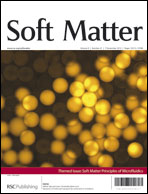Coalescence dynamics of surfactant-stabilized emulsions studied with microfluidics
Abstract
We report the results of a study on emulsion stability in a microfluidic channel flow using an integrated microfluidic device. The microfluidic circuit enables production of a monodisperse oil-in-water emulsion and monitoring of emulsion stability upon shear-induced collisions.

- This article is part of the themed collection: Soft matter principles of microfluidics.

 Please wait while we load your content...
Please wait while we load your content...